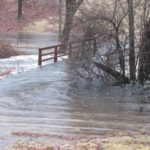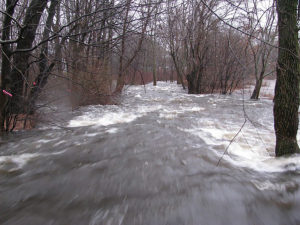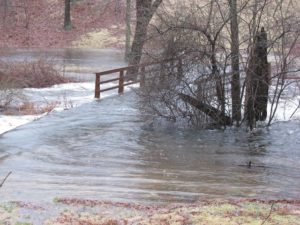
by Anne-Marie Lambert
Flooding caused the collapse of the Trapelo Road culvert over Beaver Brook in 2010, and inundated the train tracks at the Waverley MBTA commuter rail station. Belmont is expected to see its share of future big intense storms, extreme heat, and other disasters from climate change. If it’s any comfort, our town now has a preparedness plan, thanks to a state-funded program.
The Town of Belmont Hazard Mitigation-Municipal Vulnerability Preparedness Plan identifies local vulnerabilities to flooding, pollution, and traffic jams, and proposes mitigating actions, short-term and long-term, to help vulnerable populations safely shelter from extreme heat, rain, or snow.
The cost of not taking these actions is likely much greater than the cost of funding them. The town’s plan was developed by consultants Weston & Sampson under the state’s Municipal Vulnerability Preparedness (MVP) plan (see “Belmont Tackles Climate Vulnerability Planning,” BCF Newsletter, May/June 2020) which awarded Belmont $31,000 toward creating the plan’s first phase. The town’s Office of Community Development (CD) has identified alternative sources for funding the rest.
Climate Adaptation Actions
At the top of the list of high-priority actions in Belmont’s MVP plan is replacing the Trapelo Road culvert. The Trapelo Road culvert is vulnerable to collapsing and flooding in a heavy storm. Every day that goes by without the Belmont Department of Public Works (DPW) and CD coordinating with the town of Waltham to replace this culvert leaves it vulnerable. If you are a commuter driving over the metal plates by Mill Street (even with light traffic during the pandemic), think about what alternative routes you and other commuters would need to find to avoid this intersection. Making this repair in response to an emergency would be much more expensive than making it beforehand. The same goes for undersized culverts at Concord Avenue/Wellington Brook, the Clifton Street and Hickory Lane intersection, the Belmont and Lexington Streets intersection, and other locations.
Top-Priority Hazard Mitigation and Climate Adaptation Actions
General Objective |
Specific Actions |
Time Frame |
Owner |
Expense |
|
Culvert replacements and upgrades using climate projection design standards |
Replace Trapelo Road culvert |
0-1 year |
DPW, CD, Waltham |
$$$$ |
|
Roadway flooding vulnerability study |
1-3 years |
CD |
$$$ |
|
|
Increase culvert sizes to remove key bottlenecks |
Ongoing |
CD |
$$$$ per culvert |
|
|
Sewer Infrastructure |
Sewer lining and repair |
Ongoing |
CD |
$$$/yr |
|
Decrease potential leaching hazard from former incinerator site |
Install a cap |
1-3 years |
DPW, CD |
$$$$$ |
|
Stormwater computer modelling |
Model the existing drainage system under climate change scenarios |
0-1 yr |
CD |
$ |
|
Develop a comprehensive emergency response plan and ongoing communication program |
Draft emergency response plan |
1-3 years |
Police, Fire |
$$ |
|
Increase reverse-911 registrations |
1-3 years |
Police, Fire |
$ |
|
|
Improve the resilience of municipal buildings |
Install backup power in key locations |
3-5 years |
DPW, Police, Fire |
$$$ per facility |
Legend
$ < $10,000
$$ $10,000-$100,000
$$$ $100,000-$250,000
$$$$ $250,000-$500,000
$$$$$ >$500,000
DPW: Department of Public Works CD: Office of Community Development
Source: Town of Belmont Hazard Mitigation—Municipal Vulnerability Preparedness Plan, Section 7, Weston & Sampson, May 2020 draft
There is a potential quick win at the top of the priority list: pay consultants to “model our existing drainage system utilizing updated rainfall data to evaluate flooding conditions under projected climate change conditions.” Belmont and Cambridge already have all the necessary data in the same modeling software with the same consultant (Stantec) to create a regional look at flooding risks. Cambridge has based its climate change plan on a model that stops at its border with Belmont. Hence, they inaccurately modeled the Brighton Street culvert from Clay Pit Pond as a catch basin instead of a pond flowing into a culvert. Both Cambridge and Belmont are flying blind until the model is expanded to be more regional.
Other important actions on the top-priority list are two pollution prevention projects: the incinerator site and sewer system repairs. Until the former incinerator site is capped, it remains vulnerable to leaching into Beaver Brook and then into the Charles River during heavy storms. In addition to a cap, the Department of Environmental Protection requires that wetland vegetation be utilized to improve water quality at the site. Moreover, the Select Board has approved post-closure uses of Belmont Light Department sustainability projects, such as solar panels at the former incinerator site on Concord Avenue. These projects could help mitigate climate change and help achieve the goal of a 100% emission-free electricity supply stated in the Belmont Climate Action Plan of 2009.
The second pollution prevention project is to line and repair breaks in our sewer system to prevent sewage from leaking into our waterways, especially during heavy rain. Belmont made significant progress on sewer lining and repairs in 2020 and early 2021 as part of a 2017 consent order from the Environmental Protection Agency to address violations of Clean Water Act requirements, but there is still a great deal of sewer repair work to be done. The main bottleneck appears to be lack of sufficient municipal staff to oversee contractors working on multiple measurement and repair sites simultaneously (see “Carrots and Sticks Nudge Belmont’s Cleanup,” BCF Newsletter, November 2020).
In addition to the top-priority items, the MVP plan identifies some medium-priority items which could be done in the next one to three years. Thanks to state Representative Dave Rogers and Town Administrator Patrice Garvin, the town was recently able to take advantage of funding at the end of the last state budget cycle to address one of these “quick hits”; the town now has an additional $50,000 to develop a better tree management plan and to plant more trees.
During a big storm or heat wave, communication with our vulnerable populations is an important element of being prepared. Many of the communication-related priorities, such as increasing reverse-911 registrations, would also have been helpful during the COVID-19 emergency as a way to improve communications.
Finally, installing a generator at the Belmont Senior Center was identified as a medium-priority item. Installing backup power at the Chenery School, police station, and data centers were all classified as high priority.
General Objective |
Specific Actions |
Owner |
Expense |
|
Develop a comprehensive emergency response plan and ongoing communication program |
Develop a recurring protocol for examining shelter capacity, functionality, and essential equipment and goods. Develop a shelter-in-place guide or toolkit for private, multi-unit facilities |
Police, Fire |
$ |
|
Improve emergency preparedness outreach and education for vulnerable and isolated populations including the aged, youth, people whose first language is not English, people experiencing economic hardship, and people who are disabled |
Police, Fire |
$ |
|
|
Document emergency flood preparation and emergency response capacity |
DPW, Police, Fire |
$ |
|
|
Develop a fire prevention program and purchase more equipment |
FireWise Program to help educate residents on fire prevention and hazardous materials |
Fire |
$ |
|
Improve the resilience of municipal buildings |
Install a generator at the senior center |
DPW, Council on Aging |
$$ |
|
Tree management |
Increase tree maintenance efforts and funding for tree maintenance contractor |
DPW |
$$$ |
|
Develop a comprehensive tree management plan which could include planting appropriate species by taking into consideration local air quality, proximity to dense housing and roadways, drought, extreme temperatures, and wind |
DPW |
$$ |
Next Steps
A tremendous amount of time, energy, and thought went into the Town of Belmont Hazard Mitigation-Municipal Vulnerability Preparedness Plan. The consultants at Weston & Sampson followed a state-prescribed process to facilitate an all-day workshop that included many stakeholders, from municipal staff to community leaders. Even after the pandemic temporarily halted in-person public meetings, more than 100 people participated in an online feedback session and survey, possibly more than would have participated if it had been done in person. I hope the Office of Community Development tries again to apply for MVP Action Grant funding this year, and that department heads, members of the Select Board, Warrant Committee, and Town Meeting use the MVP plan as a guide when deciding the town’s 2021 annual budget priorities.
The Municipal Vulnerability Preparedness Program
The Municipal Vulnerability Preparedness (MVP) program provides grants for cities and towns in Massachusetts to begin the planning process for climate change resiliency and implementing priority projects. Communities that complete the MVP program become certified as an MVP community and are eligible for MVP Action Grant funding and other opportunities.
Belmont has completed the MVP planning process, identifying several priorities to advance progress towards resilience, and will be eligible for MVP Action Grants and Federal Emergency Management Agency grants. Belmont’s Hazard Mitigation-Municipal Vulnerability Preparedness Plan currently proposes the following:
• Convening a core team of municipal department heads who provided key input through meetings, online surveys, and interviews.
• Engaging stakeholders through a virtual community resilience-building workshop and the public through a virtual, interactive meeting.
• Conducting a vulnerability and risk assessment of historic hazards and the potential impact of climate change.
• Documenting the town’s capacity to mitigate and respond to hazards.
• Updating the progress of the previous hazard mitigation plan.
• Developing an action and implementation strategy.
Check out the Belmont MVP overview on Belmont Media.
Anne-Marie Lambert is a former director of the Belmont Citizens Forum.




Sorry, the comment form is closed at this time.